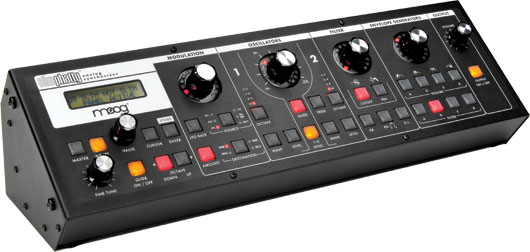Moog Slim Phatty Analog Synthesizer
The Slim Phatty (MSRP: $849), presumably named for its keyboard-less, compact, two-voice design, and highly […]

The Slim Phatty (MSRP: $849), presumably named for its keyboard-less, compact, two-voice design, and highly tweakable room-filling sonics, is the latest instrument to join Moog‘s pack of classic machines. Essentially, the Slim Phatty is the sound engine of a Little Phatty (the unit’s keyboard-equipped older brother), in a wedge-like module that is both rackmountable or tabletop. Classic wood side panels are available separately for that timeless, Giorgio Moroder-approved look. And like all of the newer Moog synths, the backlighting on the tactile buttons and bright LED markers for the dials are not only clear and useful, but darn rave-tastic with the studio lights down.
Like its older brother, the Slim Phatty includes a wealth of up-to-date features, including MIDI-over-USB with high-resolution messaging (you can easily record your movements as automation in your DAW and run that MIDI back through the unit, not only saving the performance but also making adjustments in the key editor for the perfect pass). Not forgetting its old-school origins, the Slim Phatty provides a 100% analog signal path and keeps the classic voltage-control method of speaking to other machines well intact. Using the CV feature, you can really go modular, hooking up all sorts of vintage and modern analog boxes to create your own BBC Radiophonic Workshop. And, as an added bonus, while most analog synths are not known for their mobility, this one is svelte enough to fit in your backpack, allowing the instrument to shine onstage as well.
While you can coax the sort of Moog-style squelch and punishing sub-sonics that will have you watching your bass bins (see the “O.L.” button to kick in an oomph of overload drive), a mere sweep of a filter and tweak of dial on this synth can conjure up an equally impactful bevy of cosmic, ambient, and Balearic delights. Another huge plus is the ability to send external audio through the Slim Phatty via a rear input for some wicked filtering, effectively giving you Mooger Fooger pedal-style processing in the same box. It all adds up to a cost-effective and highly recommended way of getting the legendary Moog sound into a studio of any size.

